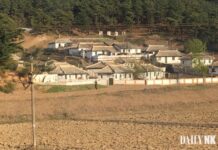On May
9th, the seventh Workers’ Party Congress in North Korean history came to a
close. Following the event, multiple publications on the topic have shown up in
the state-run Rodong Sinmun. Today, we will take a scrupulous look at these
publications and try to discern truth from distortion. Joining us is secretary general of the Association for North Korean Defectors, So Jae Pyong.
1. As expected, the May 10th issue of Rodong Sinmun is
plastered with headlines and photos of the recent Workers’ Party Congress. Most
of these photos are of Kim Jong Un. There is a lot of chatter that he had a
difficult time at the event. What do you think?
Well, Rodong
Sinmun only published pictures of Kim Jong Un posing. However, sitting down at
the congress all day long, for multiple days in a row, would certainly be rough
for someone in his physical condition. During his address, which ran for three hours consecutive, his voice was
hoarse and his bearing shoddy. In the video, we can see that he started the
address by placing his speech on the podium and reading, but by the halfway
point, he was holding it and sort of leaning on the table in front of him.
Interestingly,
we saw him holding the script close to his face while reading, which is an
indicator of poor eyesight for someone his age. Also, his voice is not the
sonorous voice of a man in his 30s, but the gravelly voice of a man in his 50s.
It’s clear that he is in less than ideal shape and is easily fatigued.
2. The last
page of the May 10th issue is loaded with various pleas to the military and
populace. They advocate “continuing to progress the dominance of socialism at ‘Mallima
Speed’.” How do you think North Koreans are reacting to this type of rhetoric?
According to everyone in North Korea with whom I’ve spoken regarding the event, the
people couldn’t care less about these pleas or their leader’s address. They
were completely drained from the “70-Day Battle” leading up to the congress and
were eagerly awaiting its finish. Furthermore, the people were hoping for
policy change regarding the markets and agriculture–their means of survival–but nothing substantive was mentioned.
Furthermore, there is a lot discontent with the various
slogans emphasizing this new ‘Mallima Speed’. They are saying, “We barely made
it by on ‘Chollima Speed’ [a slogan from previous eras], why would ‘Mallima
Speed’ be any better?” They are calling it Kim Jong Un’s anachronistic
propaganda. North Koreans are upset with a leader that is unabashedly ignorant
of his people.
Especially notable is the fact that when asked about the congress and related messaging, most people show indifference. Their
bodies were in front of the TV watching the congress, but their minds were at
the jangmadang [market economy].
3. Let’s
move on to the May 13th issue. On the front page, there is a commemorative
photo with every participant at the congress. Both the background and the
picture itself are quite spectacular. I would wager there is a propaganda
agenda at play here, but I’m curious how the people think when they see a photo
like this.
The age
of influencing people through a photo like has long since passed. North Koreans grimace
at this picture and call it “Kim Jong Un and the cadres’ Party” and “a disgraceful
sight that has nothing to do with the real people.” There is also talk that
some even spit on the picture after seeing it, criticizing its irrelevance to
their lives.
4. We saw an
article emphasizing grain production on page five of the 13th issue of the
Rodong Sinmun entitled, “This Year’s Uphill Battle for Grain” and then again
on the front page on the 16th issue, “Band Together for the Rice-Planting
Battle.” It would appear that North Korea is still dealing with their chronic
grain underproduction. What seems to be the problem?
The main
problem is that even the farmers themselves are suffering from hunger and are
therefore turning their attention away from their official farm duties and
working private secret farms on the side. This is because they till the earth
tirelessly all year long on their official farms only to have their produce
taken away for the military and State rations. They are only met with poverty
and starvation based on this system so it’s easy to see their lack of drive to
work hard for more production. Based on this, they have no other choice but to
have an almost forced production system on the collective farms. The government
needs to implement some kind of policy to improve the quality of the lives of
these farmers but that just simply isn’t the case. Farmers have zero interest
in the production of their crops because of this system. They’re really only
focused on their separate, private crops. I think the only way to alleviate the
hunger and poverty that citizens are suffering from is to completely do away
with this type of quota system.
5. After the
congress there was a mass rally, “Rise up for the construction of the great
socialist state” in Nampo, South Hwanghae Province. Everyone had already
suffered working on the “70-Day Battle” for the party congress, but then
were bothered with more preparations even after it had ended. Do you think this
created more dissatisfaction among citizens?
From what
I’ve gathered from my sources in North, those that participated in the party
congress all returned to their homes on May 16th. Those that
returned first from the congress to Nampo, South Hwanghae Province did indeed
hold a mass rally, which can really only be considered forced labor considering how exhausted residents are from the protracted mobilizations preceding the Party Congress. I predict that some citizens will probably be relatively vocal about their discontent.
















